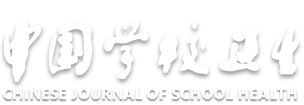Prevalence and associated factor of obesity in children aged 3-6 years in Hebei Province
-
摘要:
目的 了解河北省3~6岁幼儿肥胖的流行特征以及相关因素,为制定并执行幼儿肥胖防治策略提供参考依据。 方法 采用分层随机整群抽样的方法,抽取河北省11个地市共6 034名3~6岁幼儿作为调查对象,进行体格检查和问卷调查。 结果 河北省3~6岁男、女幼儿的肥胖检出率分别为23.00%和17.48%,差异有统计学意义(χ2=28.51,P<0.01);乡村和少数民族幼儿的肥胖检出率(20.06%,21.68%)分别高于城镇和汉族幼儿(19.97%,20.90%),差异均无统计学意义(χ2值分别为0.01,0.78,P值均>0.05)。多因素Logistic回归分析结果显示,男生(OR=1.45)、出生时体重≥4 000 g(OR=2.80)、每周吃高油脂食品≥3次(OR=1.64)、每周喝碳酸饮料≥3次(OR=4.71)、不喜欢吃水果蔬菜(OR=1.22)、每天进行身体活动<2 h(OR=1.82)、母亲肥胖(OR=2.00)、父亲不参加体育锻炼(OR=1.95)均与河北省幼儿肥胖发生呈正相关(P值均<0.01)。 结论 河北省3~6岁幼儿的肥胖检出率处在较高水平,遗传、不良饮食和生活习惯是幼儿肥胖的相关因素。需要加大对健康知识和幼儿肥胖危害的宣传力度,帮助幼儿养成健康的饮食和生活习惯。 Abstract:Objective To analyze the epidemiological characteristics and related factors of obesity in children aged 3-6 years old in Hebei Province, and to provide a reference for childhood obesity prevention and control strategies. Methods A total of 6 034 children aged 3-6 years were randomly selected from 11 cities in Hebei Province for physical examination and questionnaire survey. Results The prevalence of obesity in 3-6-year-old boys and girls in Hebei Province were 23.00% and 17.48%, which differed significantly (χ2=28.51, P < 0.01); The prevalence of obesity was higher in rural areas and children with ethnic minorities (20.06%, 21.68%) than that of urban are and Han children (19.97%, 20.09%), with no significant differences (χ2=0.01, 0.78, P > 0.05). Multivariate Logistic regression analysis revealed that boys(OR=1.45), birth weight no less than 4 000 g (OR=2.80), high-fat food consumption at least 3 times a week (OR=1.64), carbonated drinks consumption at least 3 times a week (OR=4.71), insufficient fruits and vegetables consumption (OR=1.22), physical activities less than 2 hours per day (OR=1.82), maternal obesity (OR=2.0), and lack of physical exercise of fathers (OR=1.95) were significantly associated with higher risk for obesity among young children in Hebei Province (P < 0.01). Conclusion The prevalence of obesity among children aged 3-6 years in Hebei Province is at a high level at present. Many factors contribute to this epidemic such as genetics, poor diet and living habits. Promotion of healthy eating and lifestyle, as well as dissemination of reliable knowledge about childhood obesity are greatly needed. -
Key words:
- Obesity /
- Body mass index /
- Regression analysis /
- Child, preschool
1) 利益冲突声明 所有作者声明无利益冲突。 -
表 1 河北省3~6岁幼儿肥胖相关因素的单因素分析
Table 1. Single-factor analysis of the fators related to obesity among young children aged 3-6 years in Hebei Province
因素 选项 人数 肥胖人数 χ2值 P值 出生时体重/g <4 000 3 123 423(13.54) 179.54 <0.01 ≥4 000 2 911 798(27.41) 出生后4个月是否母乳喂养 是 4 273 862(20.17) 0.04 0.85 否 1 761 359(20.39) 是否上幼儿园 是 5 752 1 132(19.68) 23.51 <0.01 否 282 89(31.56) 每周吃高油脂食品≥3次 是 2 896 816(28.18) 217.59 <0.01 否 3 138 405(12.91) 每周喝碳酸饮料≥3次 是 1 810 549(30.33) 163.29 <0.01 否 4 224 672(15.91) 每周吃甜食≥3次 是 1 509 424(28.10) 70.07 <0.01 否 4 525 797(17.61) 喜欢吃蔬菜水果 是 5 049 807(15.98) 218.90 <0.01 否 985 414(42.03) 参加文体特长班 是 1 404 267(19.02) 1.30 0.25 否 4 630 945(20.41) 每天进行身体活动的 是 3 729 548(14.70) 185.60 <0.01 时间≥2 h 否 2 305 673(29.20) 父亲为专科以上学历 是 2 641 327(12.38) 179.48 <0.01 否 3 393 894(26.35) 母亲为专科以上学历 是 1 516 313(20.65) 0.21 0.65 否 4 518 908(20.10) 父亲肥胖 是 3 615 706(19.53) 2.78 0.10 否 2 419 515(21.29) 母亲肥胖 是 1 327 343(25.85) 33.20 <0.01 否 4 707 878(18.65) 父亲每周参加1次体育锻炼 是 4 838 865(17.88) 83.94 <0.01 否 1 196 356(29.77) 母亲每周参加1次体育锻炼 是 2 580 513(19.88) 0.35 0.56 否 3 454 708(20.50) 注: ()内数字为检出率/%。 表 2 河北省3~6岁幼儿肥胖的多因素Logistic回归分析(n=6 034)
Table 2. Multi-factor Logistic regression analysis of obesity among children aged 3-6 years in Hebei Province(n=6 034)
自变量 选项 β值 标准误 Wald χ2值 OR值
(OR值95%CI)性别 男 0.33 0.09 8.74 1.45(1.26~1.61) 出生时体重/g ≥4 000 0.64 0.09 61.21 2.80(2.53~3.13) 每周吃高油脂食品≥3次 是 0.45 0.13 13.46 1.64(1.34~2.03) 每周喝碳酸饮料≥3次 是 1.68 0.27 76.35 4.71(3.54~5.32) 每周吃甜食≥3次 是 1.34 0.15 87.62 5.71(4.17~6.12) 喜欢吃水果蔬菜 否 0.41 0.11 7.98 1.22(1.02~1.68) 每天进行身体活动的时间≥2 h 否 0.52 0.11 34.58 1.82(1.52~2.11) 母亲肥胖 是 0.58 0.12 33.63 2.00(16.86~2.20) 父亲每周参加1次体育锻炼 否 0.69 0.18 22.31 1.95(1.46~2.63) 注: P值均 < 0.01。 -
[1] 国家卫生和计划生育委员会. 学龄儿童青少年超重与肥胖筛查: WS/T 586—2018[S]. 北京: 中国标准出版社, 2018.National Health Commission of the PRC. Screening for overweight and obesity among school-age children and adolescents: WS/T 586-2018[S]. Beijing: Standards Press of China, 2018. (in Chinese) [2] 陈笑征, 李一辰. 儿童肥胖的早期危险因素[J]. 中国儿童保健杂志, 2021, 29(2): 169-172. https://www.cnki.com.cn/Article/CJFDTOTAL-ERTO202102016.htmCHEN X Z, LI Y C. Early risk factors for childhood obesity[J]. Chin J Child Health Care, 2021, 29(2): 169-172. (in Chinese) https://www.cnki.com.cn/Article/CJFDTOTAL-ERTO202102016.htm [3] HAJIN J, HANNAH O. Trends and inequalities in overall and abdominal obesity by sociodemographic factors in Korean adults, 1998-2018[J]. Int J Environ Res Public Health, 2021, 18(8): 4162. doi: 10.3390/ijerph18084162 [4] SKINNER A C, RAVANBAKHT S N, SKELTON J A, et al. Prevalence of obesity and severe obesity in US children, 1999-2016[J]. Pediatrics, 2018, 141(3): e20173459. doi: 10.1542/peds.2017-3459 [5] 国家体育总局. 国民体质测定标准手册: 幼儿部分[M]. 北京: 人民体育出版社, 2003.General Administration of Sport of China. Nation physical fitness measurement standard manual: children[M]. Beijing: People's Sports Publishing Hourse, 2003. (in Chinese) [6] 国家卫生健康委员会. 关于印发全国学生常见病和健康影响因素监测方案(2018年版)的通知[EB/OL]. (2018-04-09)[2022-12-07]. http://www.nhc.gov.cn/jkj/s5898bm/201804/88cec86c347c4c48aa508b742c7abd1a.shtml.National Health Commission of the PRC. Circular on printing and issuing national monitoring of common diseases and health influencing factors among students(2018 edition)[EB/OL]. (2018-04-09)[2022-12-07]. http://www.nhc.gov.cn/jkj/s5898bm/201804/88cec86c347c4c48aa508b742c7abd1a.shtml. (in Chinese) [7] 季成叶. 中国学龄儿童青少年超重、肥胖筛查体重指数值分类标准[J]. 中华流行病学杂志, 2004, 25(2): 97-102. doi: 10.3760/j.issn:0254-6450.2004.02.003JI C Y. Body mass index reference norm for screening overweight and obesity in Chinese children and adolescents[J]. Chin J Epidemiol, 2004, 25(2): 97-102. (in Chinese) doi: 10.3760/j.issn:0254-6450.2004.02.003 [8] 国务院. 中国居民营养与慢性病状况报告(2020年)[J]. 营养学报, 2020, 42(6): 521. https://www.cnki.com.cn/Article/CJFDTOTAL-ZLBJ202102011.htmState Council of the PRC. Status of nutrition and chronic diseases in China(2020)[J]. J Nutr, 2020, 42(6): 521. (in Chinese) https://www.cnki.com.cn/Article/CJFDTOTAL-ZLBJ202102011.htm [9] 尹翠丽. 河北省1.7万余名无监护人留守儿童有了监护人[N]. 河北日报, 2019-05-31(3).YIN C L. More than 17, 000 unsupervised children in Hebei Province have guardians[N]. Hebei Daily, 2019-05-31(3). (in Chinese) [10] 原晨晨, 薛琨, 郭红卫. 全球儿童超重肥胖的流行现状和影响因素[J]. 卫生研究, 2020, 49(3): 506-510. doi: 10.19813/j.cnki.weishengyanjiu.2020.03.029YUAN C C, XUE K, GUO H W. Global prevalence and influencing factors of overweight and obesity in children[J]. J Hyg Res, 2020, 49(3): 506-510. (in Chinese) doi: 10.19813/j.cnki.weishengyanjiu.2020.03.029 [11] 王付曼, 金曦, 蒋竞雄, 等. 我国部分城市学龄前儿童超重、肥胖现状及影响因素分析[J]. 中国儿童保健杂志, 2017, 25(4): 346-349. https://www.cnki.com.cn/Article/CJFDTOTAL-ERTO201704007.htmWANG F M, JIN X, JIANG J X, et al. Situation and effecting factors of overweight and obesity of preschool children among several cities in China[J]. Chin J Child Health Care, 2017, 25(4): 346-349. (in Chinese) https://www.cnki.com.cn/Article/CJFDTOTAL-ERTO201704007.htm [12] 李辉. 儿童肥胖的现状与对策[J]. 中国医刊, 2005(5): 7-9. doi: 10.3969/j.issn.1008-1070.2005.05.003LI H. Current situation and countermeasures of childhood obesity[J]. J Chin J Med, 2005(5): 7-9. (in Chinese) doi: 10.3969/j.issn.1008-1070.2005.05.003 [13] 王艳, 王瑞, 卓志鹏, 等. 深圳市某小学青少年超重及肥胖现况调查分析[J]. 当代医学, 2014, 20(11): 3-4. https://www.cnki.com.cn/Article/CJFDTOTAL-DDYI201411002.htmWANG Y, WANG R, ZHUO Z P, et al. Investigation and analysis of the current status of overweight and obesity among adolescents in a primary school in Shenzhen[J]. Contempor Med, 2014, 20(11): 3-4. (in Chinese) https://www.cnki.com.cn/Article/CJFDTOTAL-DDYI201411002.htm [14] 张广川, 梁健平, 杨轮, 等. 出生体重及分娩方式对广州市小学生肥胖的影响[J]. 中国学校卫生, 2021, 42(2): 277-281. doi: 10.16835/j.cnki.1000-9817.2021.02.029ZHANG G C, LIANG J P, YANG L, et al. Effects of birth weight and mode of delivery on obesity of primary school students in Guangzhou[J]. Chin J Sch Health, 2021, 42(2): 277-281. (in Chinese) doi: 10.16835/j.cnki.1000-9817.2021.02.029 [15] 史平, 周甜. 饮食行为及饮食习惯对学龄前期儿童超重肥胖的影响[J]. 中国校医, 2020, 34(5): 333-334, 337. https://www.cnki.com.cn/Article/CJFDTOTAL-XIYI202005006.htmSHI P, ZHOU T. Influences of dietary behaviors and dietary habits on overweight obesity in preschool children[J]. Chin J School Doctor, 2020, 34(5): 333-334, 337. (in Chinese) https://www.cnki.com.cn/Article/CJFDTOTAL-XIYI202005006.htm [16] ZHAI L L, DONG Y D, BAI Y L, et al. Trends in obesity, overweight, and malnutrition among children and adolescents in Shenyang, China in 2010 and 2014: a multiple cross-sectional study[J]. BMC Public Health, 2017, 17: 151. [17] 谢梦. 含糖饮料与儿童青少年超重肥胖关系[J]. 卫生研究, 2018, 47(5): 862-865, 870. https://www.cnki.com.cn/Article/CJFDTOTAL-WSYJ201805037.htmXIE M. Relationship between sugary drinks and overweight and obesity in children and adolescents[J]. J Hyg Res, 2018, 47(5): 862-865, 870. (in Chinese) https://www.cnki.com.cn/Article/CJFDTOTAL-WSYJ201805037.htm [18] 陈贻珊, 张一民, 孔振兴, 等. 我国儿童青少年超重、肥胖流行现状调查[J]. 中华疾病控制杂志, 2017, 21(9): 866-869. https://www.cnki.com.cn/Article/CJFDTOTAL-JBKZ201709002.htmCHEN Y S, ZHANG Y M, KONG Z X, et al. The prevalence of overweight and obesity in children and adolescents in China[J]. Chin J Dis Control Prev, 2017, 21(9): 866-869. (in Chinese) https://www.cnki.com.cn/Article/CJFDTOTAL-JBKZ201709002.htm [19] 邱雪雁, 丁贤彬, 张春华, 等. 重庆市城乡儿童6~13岁慢性病患病率及相关行为比较分析[J]. 公共卫生与预防医学, 2013, 24(4): 21-24. https://www.cnki.com.cn/Article/CJFDTOTAL-FBYF201304006.htmQIU X Y, DING X B, ZHANG C H, et al. Comparing chronic non-com municable disease and its relevant behaviors between urban and rural children aged from 6 to 13 years old in Chongqing City[J]. J Public Health Prev Med, 2013, 24(4): 21-24. (in Chinese) https://www.cnki.com.cn/Article/CJFDTOTAL-FBYF201304006.htm [20] 王莉, 尹春燕, 肖延风, 等. 肥胖儿童膳食结构及营养素摄入情况分析[J]. 中国儿童保健杂志, 2018, 26(10): 1130-1133. https://www.cnki.com.cn/Article/CJFDTOTAL-ERTO201810024.htmWANG L, YIN C Y, XIAO Y F, et al. Analysis of dietary patterns and nutrient intake in obese children[J]. Chin J Child Health Care, 2018, 26(10): 1130-1133. (in Chinese) https://www.cnki.com.cn/Article/CJFDTOTAL-ERTO201810024.htm [21] SKINNER A C, RAVANBAKHT S N, SKELTON J A, et al. Prevalence of obesity and severe obesity in US children, 1999-2016[J]. Pediatircs, 2018, 141(3): e20173459. [22] AYER J, CHARAKIDA M, DEANFIELD J E, et al. Lifetime risk: childhood obesity and cardiovascular risk[J]. Eur Heart J, 2015, 36(22): 1371-1376. [23] 刘文利, 刘爽. 超重和肥胖对儿童发展的不良影响及对健康教育的启示[J]. 中国健康教育, 2017, 33(8): 735-740. https://www.cnki.com.cn/Article/CJFDTOTAL-ZGJK201708015.htmLIU W L, LIU S. The effects of overweight and obesity on child development and its implications for health education[J]. Chin J Health Educ, 2017, 33(8): 735-740. (in Chinese) https://www.cnki.com.cn/Article/CJFDTOTAL-ZGJK201708015.htm [24] 崔盈, 赵金玲, 程灶火, 等. 单纯性肥胖儿童心理行为问题、自我意识及家庭因素研究[J]. 中华行为医学与脑科学杂志, 2018, 27(11): 988-992.CUI Y, ZHAO J L, CHENG Z H, et al. Behavioral problems, self-awareness and family factors in children with simple obese[J]. Chin J Behav Med Brain Sci, 2018, 27(11): 988-992. (in Chinese) -

 点击查看大图
点击查看大图
计量
- 文章访问数: 518
- HTML全文浏览量: 267
- PDF下载量: 54
- 被引次数: 0





 下载:
下载: